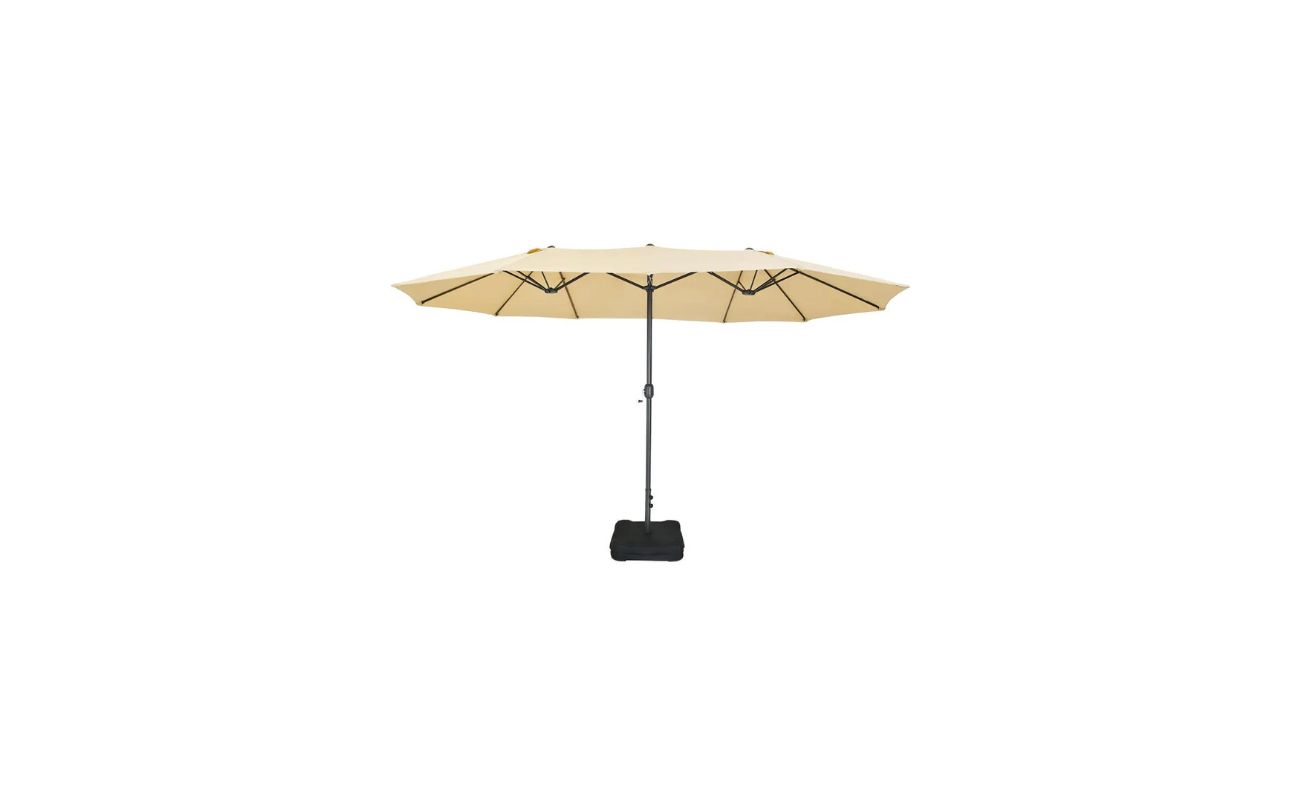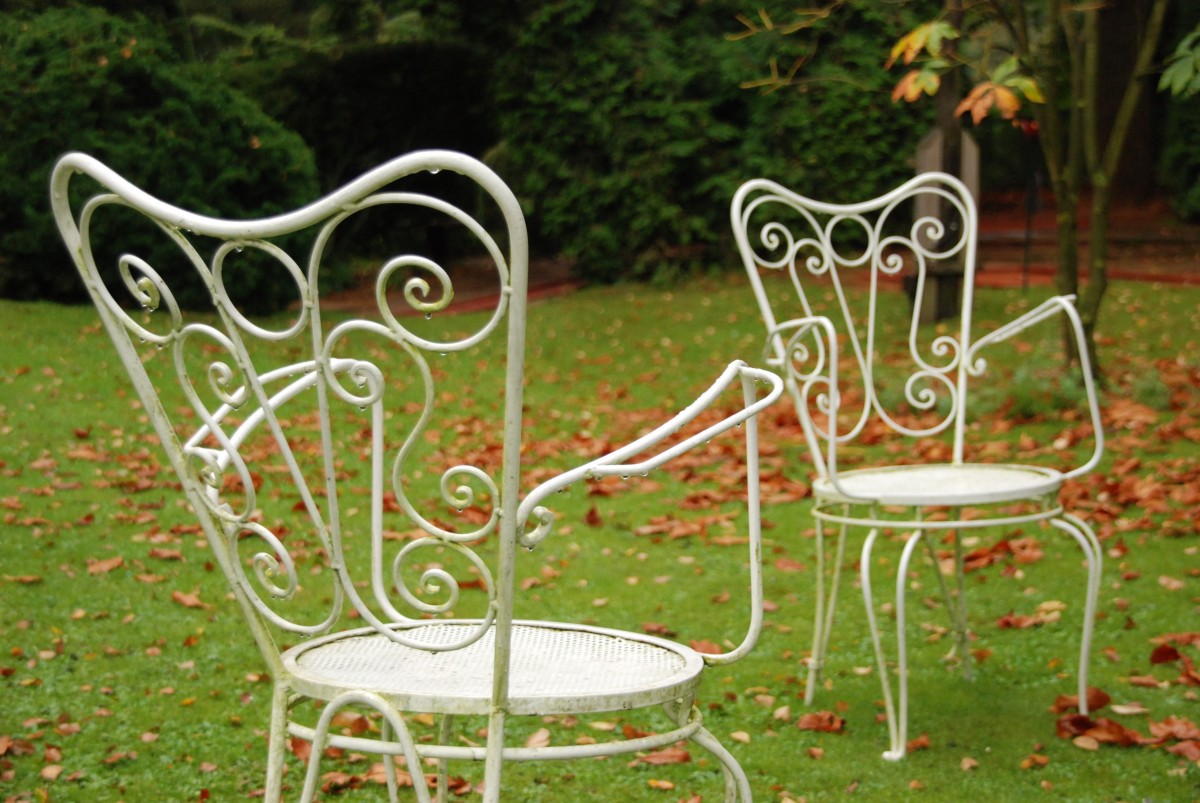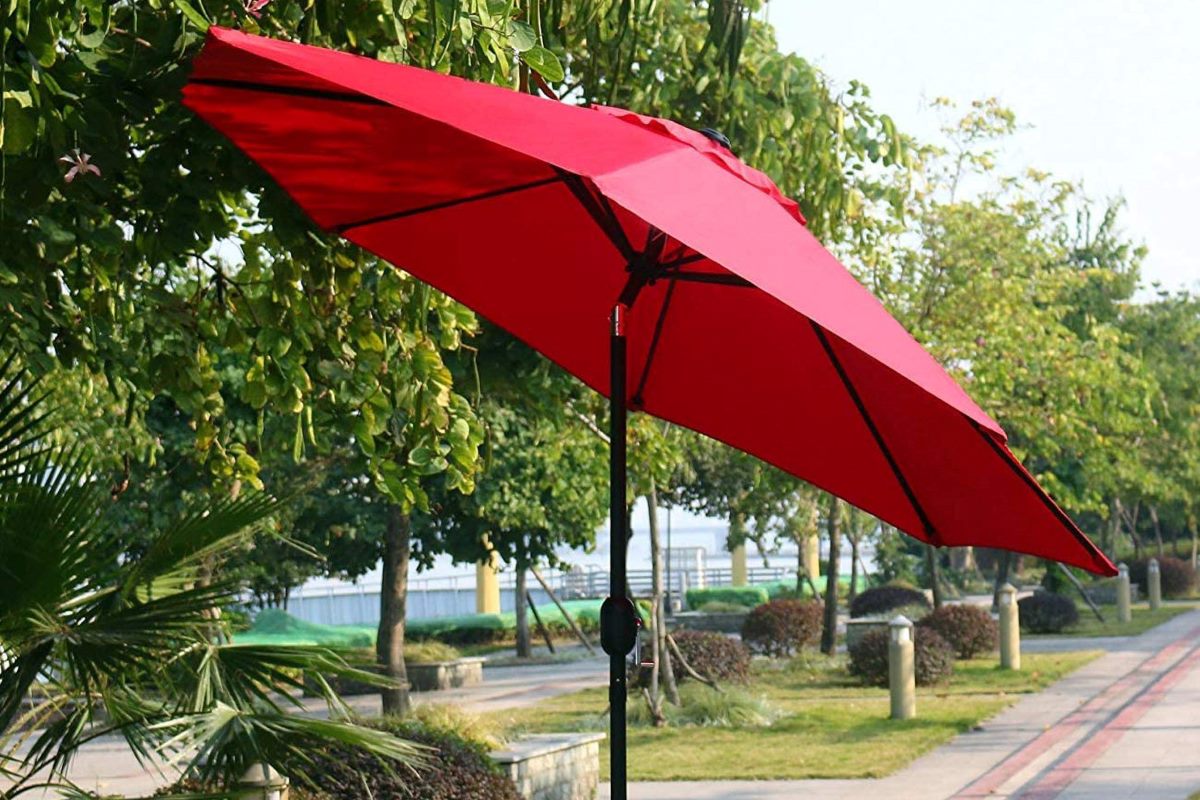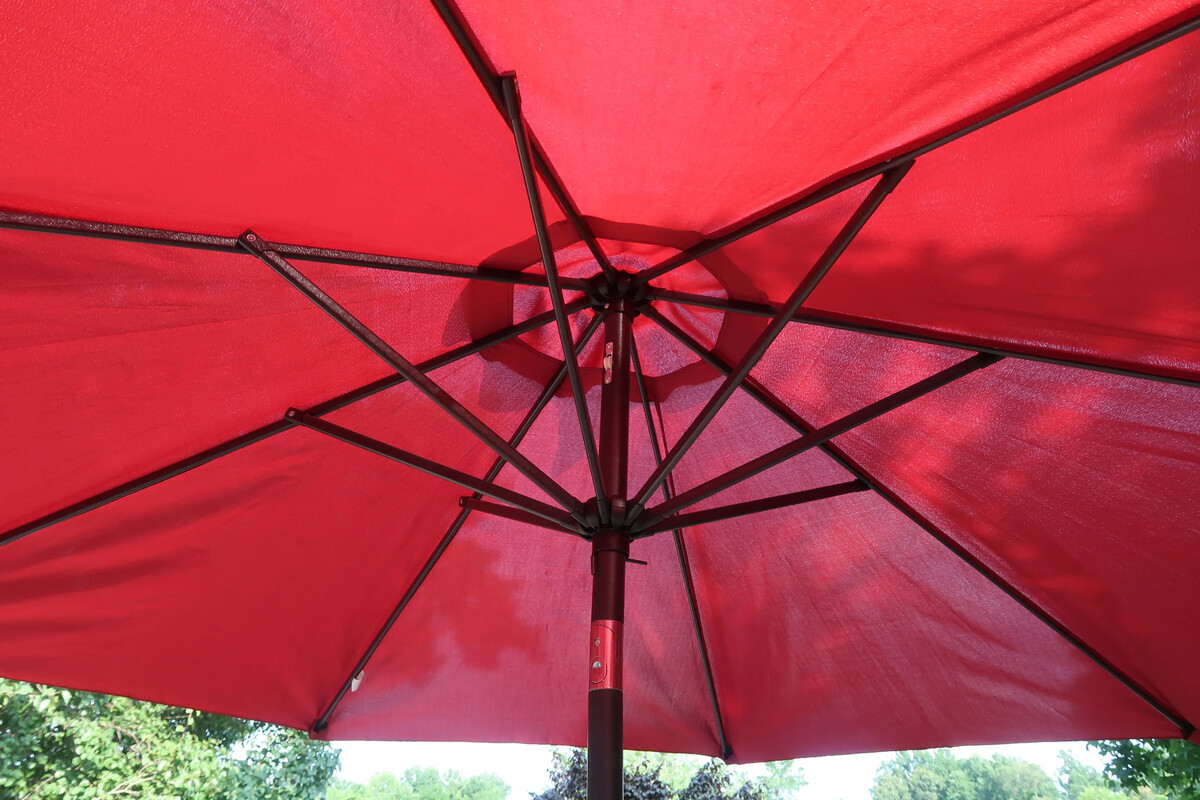Home>Furniture>Outdoor Furniture>How To Keep A Patio Umbrella From Spinning


Outdoor Furniture
How To Keep A Patio Umbrella From Spinning
Modified: August 23, 2024
Prevent your outdoor furniture from spinning with our simple tips. Keep your patio umbrella secure and stable for a relaxing outdoor experience.
(Many of the links in this article redirect to a specific reviewed product. Your purchase of these products through affiliate links helps to generate commission for Storables.com, at no extra cost. Learn more)
Introduction
Welcome to this comprehensive guide on how to keep a patio umbrella from spinning. If you have ever experienced the frustration of a constantly spinning patio umbrella, you know that it can be quite a nuisance. Not only does it create an irritating distraction, but it can also disrupt your outdoor activities and even cause damage to your furniture or surrounding items. However, fear not! There are several effective methods to prevent your patio umbrella from spinning and ensure that it stays securely in place.
Patio umbrellas are a popular choice for providing shade and comfort in outdoor spaces such as patios, decks, and gardens. They come in various designs, sizes, and materials, offering protection from the sun’s rays and allowing you to enjoy the outdoors without the worry of excessive heat or harmful UV exposure.
However, due to their lightweight construction and exposure to wind, patio umbrellas can easily spin or topple over, especially during gusty weather conditions. This can be a frustrating experience, but with the right techniques and precautions, you can keep your patio umbrella stable and secure.
In this guide, we will explore the factors that cause patio umbrellas to spin, and then delve into the methods to prevent it. From anchoring the umbrella base to using additional weight, installing a wind vent, and even opting for wind-resistant umbrella models, we will cover all the strategies to keep your patio umbrella firmly in place.
Moreover, we will provide you with some essential maintenance tips to prolong the lifespan of your patio umbrella and minimize the chances of it spinning. By implementing these measures, you can enjoy a relaxing and worry-free outdoor experience.
So, let’s dive in and discover how you can keep your patio umbrella from spinning, ensuring a peaceful and enjoyable time outdoors.
Key Takeaways:
- Prevent patio umbrella spinning by anchoring the base, adding weight, and using wind-resistant models. Regular maintenance and monitoring weather conditions are crucial for stability and longevity.
- Understanding wind, umbrella design, and maintenance helps keep patio umbrellas stable. Methods like wind vents and sturdy bases are effective in preventing spinning.
Factors That Cause Patio Umbrellas to Spin
Several factors contribute to the spinning of patio umbrellas. Understanding these factors will help you take necessary precautions to prevent your umbrella from spinning and ensure its stability. Let’s take a closer look at them:
- Wind: Wind is the primary culprit behind the spinning of patio umbrellas. When strong gusts of wind hit the umbrella, it creates an imbalance and causes it to rotate. The pressure and direction of the wind play a significant role in the spinning motion.
- Umbrella Size and Design: The size and design of your patio umbrella can also affect its stability. Larger umbrella canopies tend to catch more wind, increasing the chances of spinning. Additionally, umbrellas with a high center of gravity or inadequate support may be more prone to spinning.
- Lightweight Construction: Patio umbrellas are typically designed with lightweight materials such as aluminum frames and polyester canopies to enhance portability. While this makes them easy to handle and move, it also makes them more susceptible to wind-induced spinning.
- Umbrella Base: The stability of an umbrella largely depends on the type and quality of the base used to support it. A poorly designed or lightweight base may not provide enough stability and can contribute to the spinning of the umbrella.
- Inadequate Center Pole Support: The center pole of the umbrella is responsible for providing structural support and balance. If the center pole is weak or poorly constructed, it can lead to instability and cause the umbrella to spin.
By being aware of these underlying factors, you can take appropriate measures to mitigate the spinning of your patio umbrella. In the next sections, we will explore various methods to prevent your umbrella from spinning, ensuring a secure and enjoyable outdoor experience. So, let’s get started!
Methods to Prevent Patio Umbrella from Spinning
There are several effective methods to prevent your patio umbrella from spinning and keep it securely in place. By implementing these methods, you can enjoy a stable and hassle-free outdoor space. Let’s explore them in detail:
Anchoring the Umbrella Base
One of the most straightforward and effective methods to prevent your patio umbrella from spinning is by properly anchoring the umbrella base. Ensure that the base is firmly secured to the ground or your patio surface. You can use anchor bolts, screws, or adhesive to secure it in place. Additionally, consider using a base with a wide, sturdy design to provide maximum stability.
Using Additional Weight
To further enhance the stability of your patio umbrella, you can add additional weight to the base. This helps to counterbalance the forces of wind and minimize the chances of spinning. You can use sandbags, water weights, or even weights specifically designed for umbrella bases. Place the weights on the base or in pockets designed for this purpose to provide a solid foundation.
Read more: How To Dye A Patio Umbrella
Installing a Wind Vent
A wind vent is a feature built into the canopy of the umbrella that allows air to pass through, reducing pressure and wind resistance. Installing an umbrella with a built-in wind vent can significantly decrease the chances of spinning. The vent allows wind to pass through the canopy instead of putting pressure on it, thus maintaining stability even in gusty conditions.
Using Wind-Resistant Umbrella Models
If you live in an area with consistently windy weather, consider investing in a wind-resistant patio umbrella. These umbrellas are specifically designed to withstand strong winds and minimize the chances of spinning. Look for umbrellas with reinforced frames, sturdy canopies, and features such as wind vents and double-layered fabric for added durability.
By employing these methods, you can effectively prevent your patio umbrella from spinning. However, it’s important to remember that no method can guarantee complete resistance to spinning in all circumstances. Therefore, it’s crucial to stay vigilant and monitor the weather conditions to ensure the safety and stability of your umbrella.
Now that we have explored the prevention methods, let’s move on to some maintenance tips that will help prolong the lifespan of your patio umbrella and further minimize the chances of spinning.
Anchoring the Umbrella Base
One of the most effective methods to prevent your patio umbrella from spinning is by properly anchoring the umbrella base. The stability of the base is crucial for maintaining the umbrella’s position during windy conditions. Here are some tips on anchoring the umbrella base:
1. Choose a sturdy base:
Make sure to select a base that is designed to withstand wind and provide stability. Heavy-duty materials like cast iron, steel, or concrete are ideal choices. Avoid lightweight or flimsy bases as they may not be able to withstand strong gusts of wind and may contribute to the spinning of the umbrella.
Read more: How To Stabilize A Patio Umbrella
2. Position the base correctly:
Place the umbrella base in an area that provides maximum support and stability. Ideally, this should be on a firm, level surface such as a patio or deck. Avoid placing the umbrella on loose or uneven ground, as it can compromise the stability of the base.
3. Secure the base to the ground:
Depending on the type of base you have, there are several methods to secure it to the ground. If your base has pre-drilled holes, use anchor bolts or screws to attach it to the surface. For bases without holes, consider using adhesive or velcro straps to secure it firmly in place.
4. Utilize additional anchoring methods:
In cases where the umbrella is placed on a surface that doesn’t allow for drilling or permanent attachment, you can use additional anchoring methods. One option is using sandbags or water weights placed on top of the base to provide extra stability. Another option is using straps or ropes to anchor the umbrella base to nearby structures like fences or railing.
5. Regularly check and tighten anchoring devices:
Periodically inspect the anchoring devices and tighten them if necessary. Over time, they may loosen due to weather conditions or general wear and tear. Ensuring that the base is securely anchored will help prevent spinning and maintain the stability of your patio umbrella.
By following these guidelines, you can effectively anchor your umbrella base and minimize the chances of spinning. However, it’s important to note that extreme weather conditions such as strong winds or storms may still pose a risk to the stability of your patio umbrella. In such situations, it is recommended to close the umbrella and store it in a safe place until the conditions improve.
Now that you know how to anchor the umbrella base, let’s move on to the next method of preventing spinning: using additional weight.
Read more: How To Measure A Patio Umbrella
Using Additional Weight
Adding additional weight to the base of your patio umbrella is an effective method to enhance its stability and prevent spinning. Here are some tips on using additional weight:
1. Sandbags:
One common and relatively simple way to add weight to the umbrella base is by using sandbags. These can be purchased from hardware stores or made at home by filling durable bags with sand. Place the sandbags on top of or around the base to provide more stability. Ensure that the bags are securely closed to prevent any sand from leaking out.
2. Water weights:
Water weights are an alternative to sandbags and are specifically designed for umbrella bases. They are easy to use and can be filled with water to provide weight and stability. Water weights are typically made from durable plastic and can be easily placed on top of or around the base. Just ensure that they are properly sealed to prevent any leaks.
3. Weight plates:
Weight plates are another option to consider for adding extra weight to the base. These are metal plates that can be stacked or attached to the base of the umbrella. They come in different sizes and weights, allowing you to customize the amount of additional weight needed. Weight plates are often designed with a hole in the center, which can accommodate the umbrella pole.
Read more: How To Choose A Patio Umbrella
4. DIY alternatives:
If you prefer a more cost-effective and DIY approach, there are several alternatives you can consider. For instance, you can use heavy items such as bricks, concrete blocks, or even large rocks as makeshift weights. Just ensure that the items are securely positioned on or around the base to avoid any accidents or damage.
5. Distribute weight evenly:
No matter which method you choose, it’s important to distribute the weight evenly around the umbrella base. This helps prevent any imbalance and keeps the umbrella stable. Make sure that the additional weight is evenly spread on all sides to provide optimal support.
By using additional weight, you can significantly improve the stability of your patio umbrella and reduce the chances of it spinning. However, keep in mind that extreme weather conditions may still pose a risk to the umbrella’s stability. In such cases, it is advisable to close the umbrella and seek shelter until the conditions improve.
Now that we’ve covered anchoring the umbrella base and using additional weight, let’s move on to the next method: installing a wind vent.
Installing a Wind Vent
Installing a wind vent in your patio umbrella is an effective method to prevent spinning and enhance its stability during windy conditions. A wind vent allows air to pass through the umbrella canopy, reducing wind resistance and minimizing the chances of the umbrella being caught by gusts of wind. Here’s how you can install a wind vent:
1. Choose an umbrella with a built-in wind vent:
When purchasing a new patio umbrella, look for models that come with a built-in wind vent. These umbrellas have a small vent or opening in the canopy that allows air to flow through. The positioning and design of the vent may vary depending on the umbrella model, but the overall purpose is to reduce wind pressure on the canopy.
Read more: How To Close A Patio Umbrella
2. Retrofit your existing umbrella:
If you already have a patio umbrella without a wind vent, you can retrofit it by adding a vent yourself. This can be done by using a sharp knife or scissors to carefully cut a small hole near the top of the canopy. Make sure the hole is large enough to allow air to pass through but not too large that it compromises the overall integrity of the umbrella.
3. Reinforce the vent area:
To ensure that the vent doesn’t tear or enlarge over time, reinforce the area around the vent. You can do this by sewing a small patch of fabric over the hole or using adhesive patches specifically designed for this purpose. This will help maintain the durability and effectiveness of the vent.
4. Position the vent strategically:
When installing a wind vent, consider the positioning of the vent on the umbrella canopy. Place it in a location that allows maximum air circulation. For example, positioning the vent opposite the direction of prevailing winds can help prevent the umbrella from spinning. Experiment with the placement to find the most effective position for your specific environment.
5. Regularly inspect the vent:
Periodically inspect the wind vent to ensure that it is clear from any debris or obstructions. Leaves, dirt, or small particles can accumulate in the vent and hinder the airflow. Clearing the vent of any blockages will help maintain its effectiveness and prevent any issues that can contribute to spinning.
Installing a wind vent in your patio umbrella can significantly improve its stability and reduce the chances of spinning. However, it’s important to note that while a wind vent can provide some resistance to wind, it may not completely eliminate the possibility of spinning during strong gusts or severe weather conditions. Be cautious and use your judgment when deciding to keep the umbrella open or closed.
Now that we’ve discussed installing a wind vent, let’s move on to the next method: using wind-resistant umbrella models.
Read more: How To Secure A Patio Umbrella
Using Wind-Resistant Umbrella Models
If you live in an area with consistently windy conditions, using a wind-resistant umbrella is a great way to prevent spinning and ensure the stability of your patio umbrella. Wind-resistant umbrellas are specifically designed to withstand strong winds and minimize the risk of damage or topple. Here’s what you need to know about using wind-resistant umbrella models:
1. Sturdy construction:
Wind-resistant umbrellas are typically made with durable materials that can withstand the forces of wind. Look for umbrellas with robust frames made from materials such as fiberglass or aluminum. These materials provide strength and flexibility, making them more resistant to bending or breaking during windy conditions.
2. Reinforced canopy:
Wind-resistant umbrellas often feature canopies made from wind-resistant fabric or multiple layers of fabric. These canopies are designed to allow wind to pass through rather than catch it, reducing the risk of spinning or toppling. Additionally, look for umbrellas with reinforced stitching and robust seams for added durability.
3. Wind vents:
Many wind-resistant umbrellas come with built-in wind vents. These vents allow air to flow through the canopy, reducing wind resistance and the chances of spinning. The positioning and design of the vent may vary depending on the umbrella model, but the overall purpose is to maintain stability even in gusty conditions.
Read more: How To Keep Insects Away From The Patio
4. Tilt and locking mechanisms:
Some wind-resistant umbrellas feature tilt and locking mechanisms that allow you to adjust the canopy’s angle and secure it in place. This feature enables you to direct the umbrella away from strong winds and ensure it remains steady. Make sure the umbrella you choose has a reliable locking mechanism to keep it in your desired position.
5. Manufacturer’s wind resistance rating:
When shopping for a wind-resistant umbrella, check for the manufacturer’s wind resistance rating, if available. This rating indicates the maximum wind speed that the umbrella can withstand before it may start to experience issues. Look for umbrellas with higher wind resistance ratings to ensure optimal performance even in challenging weather conditions.
Using a wind-resistant umbrella model provides an added level of confidence and stability, minimizing the chances of spinning during windy weather. However, it’s important to note that no umbrella is completely immune to extreme winds, and it’s always advisable to exercise caution and close the umbrella during severe weather conditions.
Now that we’ve covered using wind-resistant umbrella models, let’s move on to some essential maintenance tips that will help prevent spinning and extend the lifespan of your patio umbrella.
Maintenance Tips to Prevent Spinning
To ensure the longevity and stability of your patio umbrella, regular maintenance is essential. By following these maintenance tips, you can minimize the chances of spinning and keep your umbrella in optimal condition:
1. Keep it clean:
Regularly clean your patio umbrella to remove dirt, dust, and debris that may accumulate on the canopy and frame. Use a mild detergent, water, and a soft brush or cloth to gently scrub the surface. Rinse thoroughly and allow it to dry completely before retracting or closing the umbrella. Keeping the umbrella clean will not only improve its appearance but also prevent any issues that dirt and debris might cause.
Read more: How To Make A Patio Umbrella Holder
2. Inspect for damage:
Periodically inspect your umbrella for any signs of damage, such as tears, frayed edges, or loose stitching. Repair or replace any damaged parts promptly to maintain the umbrella’s structural integrity. This will ensure that the umbrella can withstand wind and other outdoor elements without spinning or toppling.
3. Lubricate moving parts:
If your patio umbrella has any moving parts, such as a tilt mechanism or crank system, lubricate them regularly to ensure smooth operation. Apply a silicone-based lubricant to the joints and movable components to prevent rust and enable easy movement. This will help to keep the umbrella in the desired position and reduce the chances of it spinning unintentionally.
4. Store it properly:
When not in use, store your patio umbrella in a safe and protected area. Harsh weather elements, such as strong winds, heavy rain, or excessive sunlight, can damage the umbrella and lead to spinning. Consider using an umbrella cover or storing it in a dry and secure location, such as a shed or garage. If storing outdoors, make sure it is in a vertical position to prevent any deformation or stress on the frame.
5. Monitor weather conditions:
Pay attention to weather forecasts and take appropriate action based on the conditions. If high winds or storms are predicted, close the umbrella and secure it properly to avoid spinning or damage. It is better to err on the side of caution and protect your umbrella from potentially damaging weather conditions.
By following these maintenance tips, you can prolong the lifespan of your patio umbrella and mitigate the risk of it spinning. Regular cleaning, timely repairs, proper storage, and monitoring weather conditions are all crucial in maintaining the stability and functionality of your umbrella.
Now that we’ve covered the maintenance tips, let’s summarize what we’ve learned.
Read more: How To Repair Patio Umbrella Poles
Conclusion
Keeping your patio umbrella from spinning is essential for ensuring a stable and enjoyable outdoor experience. By understanding the factors that contribute to spinning and implementing the appropriate methods, you can minimize this issue and enjoy your outdoor space with peace of mind.
We explored various factors that cause patio umbrellas to spin, including wind, the size and design of the umbrella, lightweight construction, and inadequate support. Recognizing these factors helps us understand the importance of taking preventative measures.
We discussed effective methods to prevent patio umbrellas from spinning, such as anchoring the umbrella base, using additional weight, installing a wind vent, and opting for wind-resistant umbrella models. Anchoring the base firmly, distributing weight evenly, and reinforcing the canopy help to maintain stability even during windy conditions. Wind vents allow air to flow through the canopy, and wind-resistant models offer sturdier construction and features tailored for stability.
We also emphasized the importance of regular maintenance, including cleaning the umbrella, inspecting and repairing any damage, lubricating moving parts, and storing the umbrella properly. Additionally, monitoring weather conditions and taking appropriate action is crucial for preventing spinning and ensuring the longevity of your patio umbrella.
By considering these factors, implementing preventive methods, and maintaining your patio umbrella, you can enjoy the shade and comfort it provides without the frustration of constant spinning. Remember, it’s always better to prioritize safety and take precautionary measures during unfavorable weather conditions.
So, take the time to follow these guidelines and enjoy a stable and peaceful outdoor space with your patio umbrella, knowing that you have taken the necessary steps to prevent spinning and enhance its stability.
Frequently Asked Questions about How To Keep A Patio Umbrella From Spinning
Was this page helpful?
At Storables.com, we guarantee accurate and reliable information. Our content, validated by Expert Board Contributors, is crafted following stringent Editorial Policies. We're committed to providing you with well-researched, expert-backed insights for all your informational needs.







0 thoughts on “How To Keep A Patio Umbrella From Spinning”